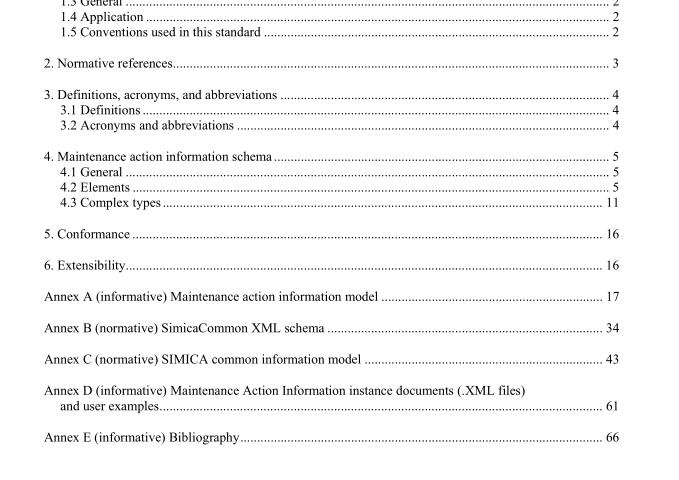IEEE 1636.2-2010 pdf download.IEEE Trial-Use Standard for Software Interface for Maintenance Information Collection and Analysis (SIMICA): Exchanging Maintenance Action Information via the Extensible Markup Language (XML)
1.2 Purpose
The purpose of this standard is to promote and facilitate interoperability between components of a test system and applications in a maintenance environment where MAI needs to be shared. The standard will facilitate the capture and exchange of unit under test (UUT) specific maintenance information, facilitating online and offline analysis of the maintenance process. The maintenance action schema defines a class of information to be used within the SIMICA family of standards.
1.3 General This standard, which is a component of the Software Interface for Maintenance Information Collection and Analysis (SIMICA) standard, was developed by the Diagnostic and Maintenance Control Subcommittee of the IEEE Standards Coordinating Committee 20 (SCC20) on Test and Diagnosis for Electronic Systems to provide standard, unambiguous definitions of maintenance information semantics and interrelationships.
This standard specifically describes a set of formal specifications consisting of the logical representation of the information that is used and generated during related diagnostic and maintenance processes. The information model contained in this document provides a normative formal specification of the information concepts and precise semantics that support the unambiguous exchange of information between producers and consumers of historical diagnosis and maintenance information in a platform independent manner.
The schemas described in this trial-use standard are intended to document the maintenance actions and events associated with the removal, repair, and replacement of system components required to maintain and support an operational system.
This information can be used to support policies, procedures, and designs resulting from the analysis of associated maintenance actions and diagnostics. The express schema in this standard is based on ISO 10303-11:1994 [B2]. 1 The XML schema associated with this standard is based on the W3C Extensible Markup Language (XML) 1.0 [B1].
1.4 Application
This trial-use standard provides a specification for information required in the development of shared maintenance data and the results of testing. Anticipated users of this trial-use standard include the following:
a) System developers
b) System maintainers
c) Test program set (TPS) developers
d) TPS maintainers
e) Automatic test equipment (ATE) system developers
f) ATE system maintainers
g) Test instrument developers
h) Developers of automatic test markup language (ATML)-based tools and systems
i) Developers of prime mission equipment that use the supported UUT as a component
j) Reliability, maintainability, and diagnostic analytical applications
1.5 Conventions used in this standard
1.5.1 General
All simple and complex types, attribute groups, and elements will be listed; explanatory information will be provided, along with examples if additional clarification is needed. The explanatory information shall include information on the intended use of the elements and/or attributes where the name of the entity does not clearly indicate its intended use. For elements derived from another source type (e.g., an abstract type),only attributes that extend the source type shall be listed; details regarding the base type shall be listed along with the base type.
The namespace prefix “c:” identifies that the type or attribute group is contained in Annex B of IEEE Std 1671-2006 (Schema-Common.xsd). 2
When referring to an attribute of an XML element, the convention of [element]@[attribute] shall be used.
In cases where an attribute name is referred to with no associated element, the attribute name shall be enclosed in single quotes. Element and type names shall always be italicized when appearing in text.
In tables that describe XML elements, the column “Use” indicates the occurrence constraints for each element. Other terms are as follows:
a) “Required” indicates that the element shall appear exactly once
b) “Optional” indicates that the attribute may appear once or not at all
c) “1..∞” indicates that the element shall appear at least once and may appear multiple times
d) “0..∞” indicates that the element may appear multiple times, once, or not at all
All specifications for the EXPRESS language are given in the Courier type font, which includes references to entity and attribute names in the supporting text.IEEE 1636.2 pdf download.IEEE 1636.2-2010 pdf download
IEEE 1636.2-2010 pdf download

Leave a Reply